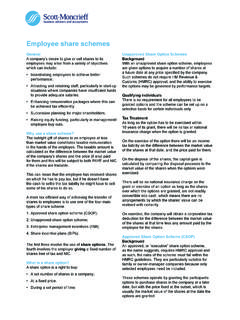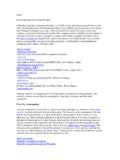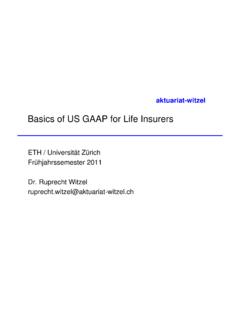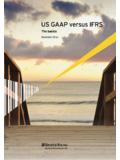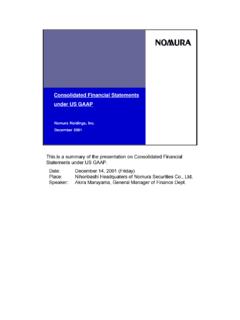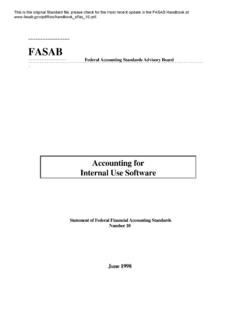Transcription of Key differences between UK GAAP & FRS 102 - …
1 1 What are the key differences between current UK gaap and FRS 102? The Financial Reporting Council ( FRC ) substantially finalised their overhaul of UK Generally Accepted Accounting Practice ( UK gaap ) last year with the publication of Financial Reporting Standard 102 The Financial Reporting Standard applicable in the UK and Republic of Ireland ( FRS 102 ). This will apply to accounting periods beginning on or after 1 January 2015 (although earlier adoption is permitted). The following guide highlights the key differences between current UK gaap and FRS 102. We have also prepared a FRS 102 - Initial checklist to help you quickly identify areas that may affect you on transition to FRS 102. Area Changes Primary statements These may be renamed in line with the titles used under EU IFRS: 1. Profit and loss account changes to income statement 2.
2 Statement of total recognised gains and losses is replaced with the statement of comprehensive income 3. Balance sheet changes to statement of financial position 4. Shareholders funds changes to statement of changes in equity 5. Cash flow statement changes to statement of cash flows. The cash flow statement now includes cash and cash equivalents . FRS 102 also has fewer headings on the face of the cash flow statement. Although the terminology has changed, you can choose to use titles other than those noted above, providing they are not misleading. In some instances, where relevant conditions are met, some of the above statements can be combined. Prior period adjustments Under FRS 102 this will be required for material errors, whereas under existing UK gaap it was a requirement for fundamental errors. A fundamental error is generally understood to be a higher threshold than a material error, therefore under FRS 102 more prior period adjustments are expected to be recognised.
3 (Note: The requirement for a prior period adjustment on a change of accounting policy remains) 2 Area Changes Disclosure exemptions for parent and subsidiary accounts FRS 102 grants exemptions from presenting the statement of cash flows, financial instruments disclosures and related party transactions with and between parents and wholly-owned subsidiaries. These exemptions will be available in both parent and subsidiary companies individual accounts, provided that the subsidiary is included in consolidated accounts which include the relevant disclosures, are publicly available and that there are no objections from shareholders. Intangible assets Under current UK gaap there was a rebuttable presumption that the useful economic life (UEL) for the purpose of amortisation would not exceed 20 years. When applying FRS 102, if a reliable estimate of the UEL cannot be made, this should not exceed 5 years.
4 Property, plant and equipment You have the option of adopting a policy of revaluation under both existing UK gaap and FRS 102. UK gaap includes more prescriptive guidance on the frequency of valuations than FRS 102. FRS 102 requires revaluation with sufficient regularity to ensure that the book value does not differ materially from the fair value. The requirement is therefore driven by material movements in fair value rather than a prescribed frequency. Investment property UK gaap requires investment properties to be revalued each year at open market value (considered to be equivalent to fair value). FRS 102 requires revaluation each year at fair value with changes in fair value taken to the income statement. Under FRS 102, if fair value cannot be measured without undue cost or effort, an acceptable alternative method may be adopted. The definition of investment property will change under FRS 102 to include properties leased to other members of the same group in the individual accounts of the lessor but not in the consolidated accounts.
5 Previously under UK gaap the definition did not include properties leased to members of the same group. Investment in associates and joint ventures FRS 102 now makes a distinction between jointly controlled entities, jointly controlled assets and jointly controlled operations. Current UK gaap considers the substance of the arrangement when classifying a joint venture. Under FRS 102, classification as a jointly controlled entity is driven by whether there is the creation of a separate legal entity. Both existing UK gaap and FRS 102 use equity accounting to account for both associates and jointly controlled entities. Gross equity accounting is required for joint ventures under UK gaap but regular net equity accounting will be required for jointly controlled entities under FRS 102. Under FRS 102, losses are no longer recognised when the value of the investor s interest in an associate or joint venture reaches zero, unless the investor has a legal or constructive obligation to make good its share of the losses.
6 3 Area Changes Business combinations Under FRS 102 fair value adjustments will only be made after the acquisition date if they are identified within 12 months of the business combination and are adjusted retrospectively. Thereafter they are only treated as adjustments to the initial accounting in order to recognise a material error. Under FRS 102, intangible assets should be recognised separately upon acquisition, if their fair value can be measured reliably. Under UK gaap intangible assets are rarely recognised separately from goodwill. This means under FRS 102 more intangible assets are likely to be identified separately from goodwill. There are no changes in the requirement to prepare consolidated accounts. The exemptions are based on Companies Act 2006 rules. Listed investments Under current UK gaap , investments held in listed shares may be measured at cost or fair value.
7 FRS 102 requires the use of fair value for investments in shares which are publicly traded or where the fair value can be measured reliably. Movements in fair value are recognised in the income statement. Leases UK gaap and FRS 102 classify leases into finance leases and operating leases based on whether the lessee or the lessor holds the risks and rewards of ownership. Current UK gaap includes a presumption that where the present value of the minimum lease payments is 90% or more of the fair value of the asset, then the lease is a finance lease. FRS 102 does not include this 90% test . The classification of some leases may change. Lease incentives will be spread over the term of the lease under FRS 102 and not the shorter of either the period to the date of the first market rent review or over the lease term, as under current UK gaap . FRS 102 requires disclosure of the total future minimum lease commitment rather than the annual lease commitment as under UK gaap .
8 Employee benefits There is no specific requirement to account for holiday pay under current UK gaap . The relevant accrual or prepayment will be required under FRS 102. 4 Area Changes Defined benefit pension plans The measurement of the net finance cost under existing UK gaap is based on determining the yield on scheme assets and applying a discount rate to scheme liabilities. Under FRS 102 the finance cost is derived by applying the discount rate to the net scheme liabilities. As the yield on scheme assets is usually higher than the discount rate applied to scheme liabilities, the finance cost will increase for schemes with pension deficits. Where current UK gaap previously allowed multi-employer exemption in groups to not reflect the defined benefit plan surplus or deficit in individual company accounts, FRS 102 will remove this exemption and the plan surplus or deficit must be reflected in the individual accounts of the sponsoring entity or the individual accounts of other group entities as appropriate.
9 Under existing UK gaap , where an employer is unable to identify its share of the assets and liabilities of a multi-employer defined benefit pension scheme, the scheme is accounted for as a defined contribution scheme. FRS 102 will allow this treatment also. However, where a funding agreement is in place to fund a deficit on such a scheme, FRS 102 requires the recognition of a liability in relation to the payments due under that agreement. FRS 102 will also bring simplifications to the projected unit credit method of measuring defined benefit liabilities, permitted on grounds of undue cost or effort. Deferred tax Although both current UK gaap and FRS 102 apply a timing difference approach to deferred tax, based on the non-alignment between the period in which gains and losses are accounted for in the performance statements and the period in which the tax effects arise, there are differences in the way that this is applied.
10 The change is likely to make the calculation of deferred tax more complex and give rise to more deferred tax balances. For example, FRS 102 will require deferred tax to be accounted for on items such as the revaluation of properties, which UK gaap does not require. Discounting of deferred tax balances is not permitted by FRS 102. 5 Area Changes Financial instruments FRS 102 distinguishes between basic and other financial instruments. The former are mostly measured at amortised cost, the latter mostly at fair value, with movements being recognised in the income statement. Companies will also have the option of adopting the recognition and measurement criteria of EU IFRS with the disclosures as specified in FRS 102. The most significant change is that receivables and payables that carry no interest, or interest below market rates, which are currently valued at book cost under current UK gaap , are measured at amortised cost using the effective interest method under FRS 102.
